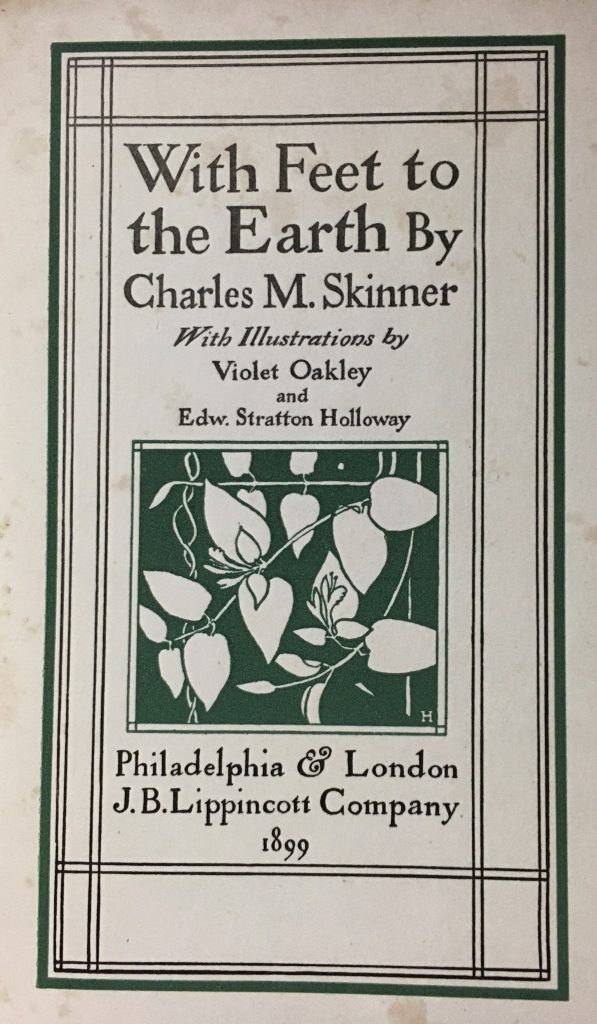
Night on the house-top frees the way to a solitude that can be terrifying; and as your mind swims away through the star-frosted deeps, you check it, now and again, with a gasp, and bring it back to earth, just as you clutch the shrubbery when you look down into a Western cañon, lest your body make excursions to the bottom likewise. This earth is a bubble of cooling lava circling its parent sun; the sun is one luminous drop in a flood of suns that we see as the Milky Way; that, again, is but an episode in the unthinkable vastnesses that extend beyond, beneath, around it. What, then, are we? But be calm. Nature is so. Be at one with it. In the multitude of lights out there, not one is varying from its course, not one falters or hastnes, seldom does one brighten or grow dull: therefore, know that we are sheltered and saved by law; that we are parts of an infinite order; and we dream that somewhere in the universe, whose sun-clouds roll about the throne of it, dwells Mind.
IN 1899, CHARLES MONTGOMERY SKINNER PUBLISHED “DO-NOTHING DAYS” ALONG WITH A SECOND EDITION OF “WITH FEET TO THE EARTH”, OFFERING THE TWO AS A BOX SET ENTITLED, “THE DO-NOTHING LIBRARY.” Skinner’s volumes are highly uneven compilations of landscape (and seascape) vignettes, Thoreauvian aphorisms (often semi-paradoxical or at odds with societal norms), fragments of memory, and shreds of advice to travellers. Having finished the first volume (“With Feet to the Earth”), I decided to read the second and author a single blog post on the pair. To my surprise and delight, the second one proved to have a richer trove of insights. I also discovered more of the cosmic wonder that (briefly) graced his book I had previously read, “Nature in a City Yard”. There were clearly moments in his life (and writing) in which Skinner confronted the vastness of the universe, and struggled with its implications for humanity. For instance, at the close of his essay, In the Desert, he reflected on the work the Mormons had accomplished, founding Salt Lake City and turning the desert landscape into a fertile plain, and pondered how that same transformation could someday be accomplished throughout the arid lands of the West. The result was a literary journey into the depths of that most haunting question of being, “Why?” — a journey that portends the existential angst of the mid 20th century and beyond.
Men make little impress upon the earth, yet we look for the time when the salt shall be washed or neutralized out of this soil, its flintiness assuaged, trees and grass mde to grow where nothing larger than willow nor more succulent than sage can be found at present, melted snow brought from the mountains and sent abroad in cooling streams, lakes and reservoirs created to hold the overflow, roads cut across the hills, and cities summoned out of the rocks. Onward and ever onward to physical conquest, if not more, the race portends. This lifeless empire will yet be peopled, must be peopled, for the race of man will presently lack room on this globe; and the lonely ones, the asking ones, looking from their chambers or their peaks upon the transmuted plain and its ondrawing multitudes, will ask again, “To what end is life? What is the gain that makes these men so desperate to keep foothold or lawhold on the earth, to win the wilderness to fertility? Is this race sufficient to itself, and no more? If to something else, what can that something be, that profits by our homage or our striving? Had men been uncreated, the globes would still have rolled through space, as bald of life as if these fields were when they were desert; yet, had suns and planets never been, what then? Would space have listened for us, questioned, expected, wished, or set in action the sleeping world germs? We come: is earth the richer save for the moment? We go: do we gain by leaving? What can these crowds advance that would not as well be left without beginning? Of what use to live through eternity, even to advance ourselves?”
Time passes. The cities of all lands increase and multiply, each a builded paradise, where temples, museums, and halls shine amid groves and gardens, and towering phalansteries overlook a nature as green, as wild, as sweet, as friendly, as it is to-day. The people are strong, large, beautiful, and wise. Their minds are fed by contact with strong schools and lofty arts. Yet among them the same questioners walk apart and ask, “Why do we build, and why is the earth fair? How are time and space the better for our world and us, and how are we better for the world, the void, eternity?”
The ages roll solemnly along. The world is dead and frozen, its stony peaks and blasted plains still more a desert than these wilds are in our day. The sun hangs like a fading coal. No thing remains alive. Traces of men are gone. An aged ghost wanders about the globe that used to be its home, and asks again, “Why was the earth made? Since men came only to vanish, how were they the better for having lived?” He sees that, with the dying of the sun, the stars and comets are shining brighter. A wind, the last of the air, moves by and whispers, “Wait!”
In another passage from the same book, but this time in an essay On the Roof, Skinner confronts mortality again — this time, not death of humanity and the Earth, but individual death, and the hope for a gift of insight at the moment of passing, to make it all worthwhile:
Death and beauty; they are nearly as close as death and life. And what are those disclosures that are made to the dying? Why do so many go to their rest with smiling wonder? The materialist says that there is no future for us; were it so, it might still be worth a life to gain one glimpse of the great mystery, just as we are giving back the spirit to its source — to hear one chord of the great symphony, to see one ray of creation’s light.
WOULD THAT SKINNER HAD CRAFTED A BOOK WOVEN OUT OF VISIONS AND WONDERS LIKE THESE; I SUSPECT IT WOULD HAVE BECOME A CLASSIC FOR THE AGES. But alas, the same book grappling with these cosmic questions included essays on Some Cheap Delights and A Few Dollars’ Worth of Europe. Some of his essays were a barrage of thoughts to live by, with occasional morsels, like this one:
When you say that you must have “life”, you commonly mean noise, bluster, effort, crowd. Why, friend, the woods are full of life; it shines on you out of the sun, stirs in the earth beneath you, falls on you in the rain, talks to you in the wind. Hear birds, see squirrels, fish, snakes, flies, and the voiceless yet whispering trees. Learn the ways and speech of wild things, and you will know life.
IN ONE ESSAY, MENTIONED BEFORE , SKINNER VIVIDLY EVOKED THE EXPANSIVE BARREN SPACES OF THE WESTERN DESERT. At a time when most nature writers focused their essays on the commonplace and rural East, Skinner’s In the Desert is a powerful testament to the dusty Western wilds:
Distance is a factor in our enjoyment of the desert. Indeed, the ocean-like vastness of the plains is the reason for the vastness of imagination and spirit that may beset us there. The human soul craves room. It has it in these wastes. Down in the hollows the desert is less impressive, and bodily discomforts are multiplied. It is hot, and sharp dust enters your eyes, mouth, nose, and ears. The ground is full of the old sea salt, and in the wind, that always blows as gloriously as on the sea, stinging the blood and inflaming the sense of liberty so that we want to rush about and yell — in this wind the white dust rises and stalks in columns across the earth. You see it in Nevada, spiring up and up, as water-spouts rise on the ocean, whiling as it advances, and finally breaking in a dry rain against the purple hills.
Two years later, John Charles Van Dyke would publish his largely fictionalized volume, “The Desert: Further Studies in Natural Appearances” and go down in history as the first writer to write positively and evocatively about the desert landscape.
ONE OTHER WAY IN WHICH SKINNER WAS A BIT AHEAD OF HIS TIME WAS IN HIS REJECTION OF ANTHROPOCENTRISM. In an age in which many people still viewed animals as mechanical and without intelligence or individuality, most everyone thought of nature as being there for humans to use and abuse at will. Gifted with a cosmic perspective, Skinner was able to see that the unfolding story of evolution was not just about human beings.
One of [nature’s] lessons is hard for us to learn, for it is the lesson of modesty, or reserve. There are men so made that they look patronizingly over the mountains, the sea, the prairies, the sky, all those symbols of the infinite, and say, “How nice it is that these things were created especially for us!” For them! little accidents of evolution; insects of a day, bumbling over this brief globe. Nay, truly, the bird, the bat, the tree, the flower, have the same right, cause, and purpose here as men. We are, happily, come in time to enjoy this beauty that is the world.
I will close with Skinner’s invitation to his readers to engage deeply and sensorially with nature, and thereby receive the energy of the cosmos:
When weather and disposition permit, …sprawl on the grass, inhale its acid fragrance, note the life the wriggles and scuttles beneath it…. Thus to rest between earth and sky, the sun ninety-three million miles over your head and warming it, eight thousand miles of rock beneath you, and life leaving darkness to meet the sun, is to be yourself penetrated by the vital currents that shape creation out of chaos.

TO CLOSE, I OFFER A QUICK WORD ABOUT THE VOLUMES I READ. Both of them were identical, apart from their different titles. Both volumes were, alas, heavily foxed, though otherwise in excellent condition for being over 120 years old. Violet Oakley’s cover is stunning; Holloway’s scattered watercolors lose quite a bit for being in black and white, I think. Neither volume had any owner’s signatures or other traces of its past.
Beautifully done. Thank you Clifford for giving my fevered mind a holiday.
You are very welcome, Becky. I am discovering such amazing gems hidden in long-forgotten volumes of obscure authors from over a hundred years ago….
When I read, I often make notes of the thoughts of others that resonate with mine. Your essay caused me to search for this one:
I think..
there can’t be a reason for the world’s existence, and hence that the very question is meaningless (Adolf Grunbaum) – answer to “why does the world exist?”
Having just celebrated my 85th birthday, I am content with this thought.
E.C., Happy 85th to you!
What impresses me about Skinner’s writings here is that this is a question very few people were asking back in 1899. It presages a much more modern outlook on the cosmos and our place in it. For my own part, I have to agree with Gordon Lightfoot on this one, in his early song, “Wherefore and Why” — https://www.youtube.com/watch?v=RsfBjXHb_l8 — “Then all at once it came to me, I saw the wherefore, and you can see it if you try / It’s in the sun above, it’s in the one you love, you’ll never know the reason why.”